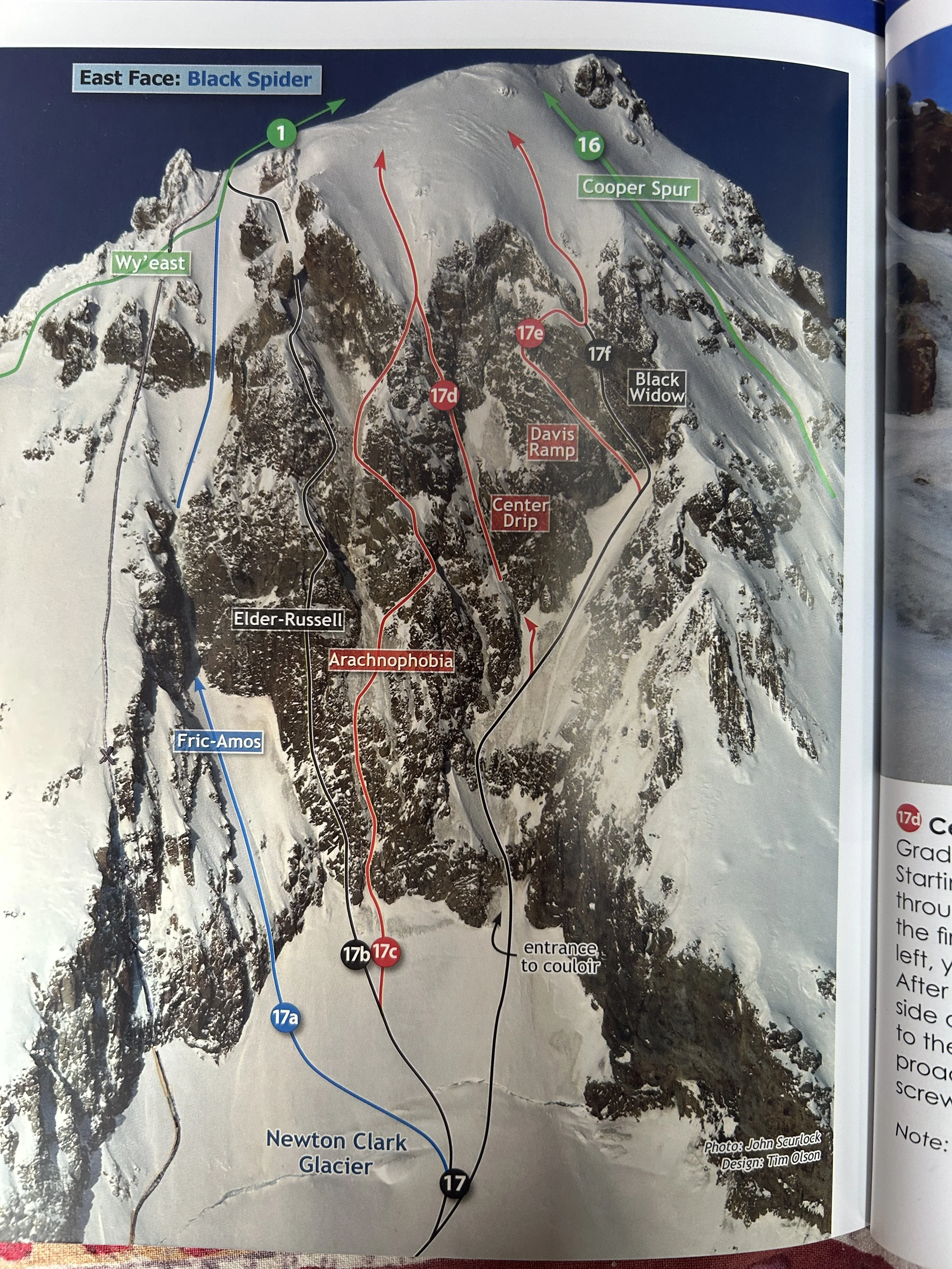Shelob’s Lair
Mt. Hood’s Black Spider is an east-facing amphitheater with a notorious reputation for friable rock, fickle ice conditions, and significant commitment— especially for routes that don’t boast head-turning stats by modern standards of cutting-edge alpinism. However, the thin icy veins make you feel like one errant swing of an ice tool could alert the Black Spider to the arrival of its next meal.
After months of texting back and forth, Matt and I finally found a window where our schedules aligned with conditions, so at 3 AM on April 13th, we skinned out of the Timberline parking lot with climbing boots on our backpacks. We skinned to 9000 feet, where we stashed our skis and transitioned to mountaineering boots and crampons to contour east around the mountain until we reached the base of the Black Spider amphitheater.
All we knew about the route was from a brief note in an old guidebook: “unclimbed waterfall.” Matt had attempted the route the previous week with different partners, but deep and unconsolidated snow conditions prevented them from even reaching the base. Only a week had passed between attempts but several freeze-thaw cycles had consolidated the snowpack into a firm and efficient surface.
We reached the base of the Black Spider amphitheater as the sun rose at 6:15 AM. The light revealed consistent ice filling the nearby Fric-Amos runnel, giving us hope that our corner would be climbable. After a short break, we tied into the rope, crossed the bergschrund, and hugged the left wall of the amphitheater until we were directly underneath the route.
What had looked like a narrow low-angle ribbon of ice from afar, now slithered nearly vertically up the corner above us. Matt took the first pitch, navigating thin, aerated, and delaminating alpine ice. Surprisingly, the left-side wall of the corner was solid rock and not the classic Mt. Hood compressed mud shmoo.
The first pitch relied heavily on stemming to surpass sections of exceptionally poor ice. Matt climbed about 30 meters through two vertical steps, the second narrower and thinner than the first, before reaching a lower angle section with solid rock on the right where he built an anchor with a piton and a couple of nuts.
The thin ribbon of ice continued for about 10 meters into the second pitch, culminating in the crux of the route: a crumbling curtain of sun-baked ice that spilled over a boulder. Along the left wall, there was a thin but solid flake that protruded from the corner. I hand-jammed behind the flake and torqued my pick into a horizontal crack below the boulder. The rock crumbled as my pick set in, which made the move feel scrappy but secure.
Above the boulder, the ice was significantly more moderate and consistent. A couple more steps of classic Mt. Hood AI 3-ish climbing brought me to the lip of the Black Spider and the end of the technical climbing. This was about 30 meters from the belay. Now that I was on a steep snow slope, and without a picket, my options for building a belay were severely limited. I dug down to a condensed layer of alpine ice and hammered the pick of my ice tool to the hilt. I equalized a micro-traxion from my ice tool and a screw and put the rope through the micro-traxion. Certainly not ideal. I continued up the slope and reached the base of a small rock buttress at exactly 60 meters. Luckily there was a crack that fit two nuts, and I was able to belay Matt off a proper anchor.
I stomped out a stance big enough for two at the base of the small rock buttress and took my first relaxed breath of the day as the morning sun embraced me with its pleasant warmth. Matt’s head appeared over the lip of the Newton-Clark and even from 30 meters away, I could see the “WTF, man!” expression when he saw the ice-axe, screw, micro-traxion situation. Needless to say, he was happy to reach the higher anchor that connected him to the mountain.
We decided to climb to the summit, which consisted of booting up the Newton-Clark headwall with a few detours to climb low-angle ice bulges. At 11 AM, we reached the summit and descended the Old Chute back to our skis.
Less than a week later we were zooming back up the Timberline road at 2 AM for a go at another Black Spider route. Unfortunately, this is as far as we’d make it into our day before getting turned around by a very unamused ODOT employee.
We brought a 60-meter rope, a couple of ice screws of each length, a single rack of cams, nuts, and a small selection of pitons.
Many of these photos were taken by Matt Zavortink.













